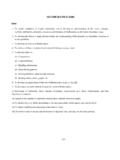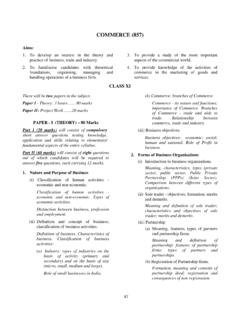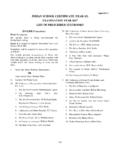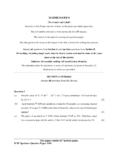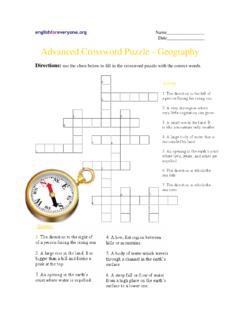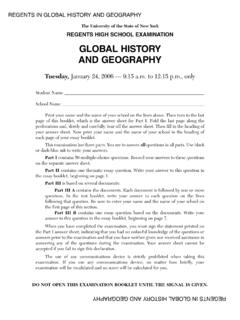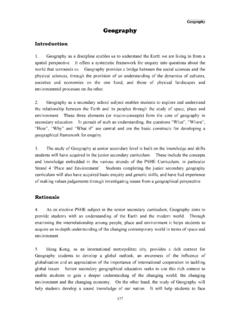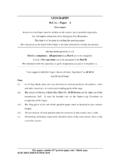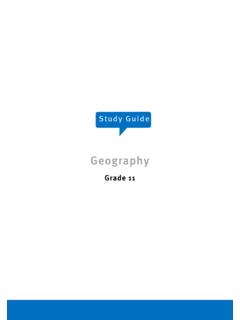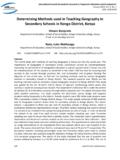Transcription of HISTORY CIVICS & GEOGRAPHY - CISCE
1 49 ICSE Specimen Question Paper GEOGRAPHY Paper 2 (Two hours) Answers to this Paper must be written on the paper provided separately. You will not be allowed to write during the first 15 minutes. This time is to be spent in reading the question paper. The time given at the head of this Paper is the time allowed for writing the answers. Attempt seven questions in all. Part I is compulsory. All questions from Part I are to be attempted.
2 A total of five questions are to be attempted from Part II. The intended marks for questions or parts of questions are given in brackets [ ]. To be supplied with this Paper: Survey of India Map Sheet No. 45D/7 and 20 cm of twine. Note: (i) In all Map Work, by a wise use of arrows to indicate positions of countries, cities and other insertions that you make, you will be able to avoid overcrowding parts of the map. (ii) The extract of Survey of India Map Sheet No. 45D/7 must not be taken out of the examination hall.
3 It must be handed over to the Supervising Examiner on the completion of the Paper. (iii) The Map given at the end of this question paper must be fastened with your answer booklet. (iv) All sub-sections of each question must be answered in the correct order. (v) All working including rough work should be done on the same answer sheet as the rest of the answer. 50 Specimen 2011 PART I (30 Marks) Attempt all questions from this Part Question 1 Study the extract of the survey of India Map Sheet No.
4 45 D/7 (Eastings 91 to 01 and Northings 73 to 83) and answer the following questions: (a) Give a six figure grid reference of: (i) Spot height . 542. [1] (ii) Temple at Juvol. [1] (b) (i) What is meant by the term R F? [1] (ii) What is the total area of the given map extract in kilometres? [1] (c) Calculate the distance in kilometres along the cart track linking Juvol in grid square 9282 to Arniwada in grid square 9481. [2] (d) (i) What is the direction of the main river given in the map extract?
5 [1] (ii) On which bank of the main river is the village Chekhla situated? [1] (e) (i) What is the main form of irrigation in the South East area of the map extract? [1] (ii) Give a reason why the streams in grid square 9478 do not join a river. [1] (f) (i) Identify the land form shown by the contours in grid square 9473. [1] (ii) What does 4r written against the blue dot in grid square 9973 represent? [1] (g) (i) In what way is the pattern of settlement in grid square 9576 different from that in grid square 9774?
6 [1] [1] (ii) What difference do you notice in the pattern of drainage in grid square 9574 and the drainage pattern in grid square 9382? [1] (h) (i) What is the compass direction of Antroli from Sangla ? [1] (ii) Which is the most important settlement shown on the map extract? Give a reason for your answer. [1] (i) (i) Name one manmade and one natural feature in grid square 9473. [1] (ii) Identify the feature given in black curved lines in grid square 9679.
7 [1] (j) (i) Name any two modes of transport used in the given map extract. [1] 51 ICSE Specimen Question Paper (ii) What inference can be drawn about the general occupation of the people living in the South East area of the map extract? Give a reason for your answer. [1] Question 2 On the outline map of India provided: (a) Eastern Ghats and Western Ghats. [1] (b) River Chenab.
8 [1] (c) Mark with arrow, the direction of the Bay of Bengal branch of South West Monsoon. [1] (d) Shade and name an area where red soil is found extensively. [1] (e) The Longitude 82 E. [1] (f) Coromandel Coast. [1] (g) Nathu-La-pass. [1] (h) Mark and label the leading states for coal and iron ore. [1] (i) Shade and name the state with highest density of population. [1] (j) Mark with a red dot and name Allahabad. [1] PART II (50 Marks) Attempt any five questions from this Part. Question 3 (a) Name the different seasons in India stating the months when they are experienced.
9 [2] (b) (i) Why is the annual range of temperature more at Agra than at Mumbai? (ii) Name a region in India which receives rainfall both in summer and winter. [2] (c) (i) Explain in what way are retreating monsoon winds different from North East Monsoon winds. (ii) Give two reasons why Arabian Sea branch of the South West Monsoon does not shed any moisture in Western Rajasthan. [3] 52 Specimen 2011 (d) Study the climatic data of two cities of India provided below and answer the questions that follow: Month Jan Feb Mar Apr May Jun Jul Aug Sep Oct Nov Dec Station A Temperature ( C) Rainfall (cm) Station B Temperature ( C) Rainfall (cm) ----- ----- ----- (i) Calculate the annual range of temperature of Station A.
10 (ii) What is the total rainfall experienced by Station B? (iii) On which coast is Station A situated? Name the rains that bring rainfall to this region. [3] Question 4 (a) (i) How is black soil formed? (ii) Name one cash crop for which black soil is most suited. [2] (b) (i) Name the transported soil most widely found in India. (ii) How is this soil formed? [2] (c) (i) Name the soil found on the summits of Eastern Ghats. (ii) How is this soil formed? (iii) Why is this soil not suitable for cultivation?



